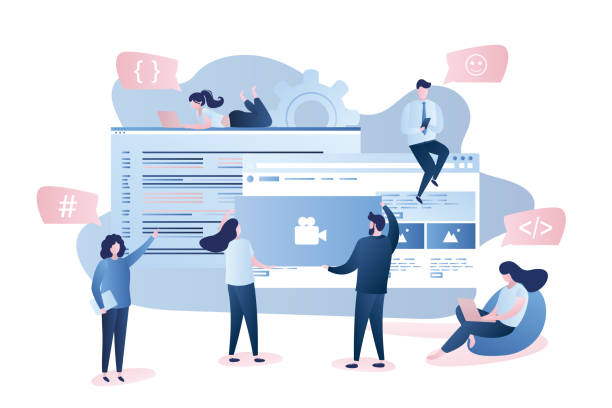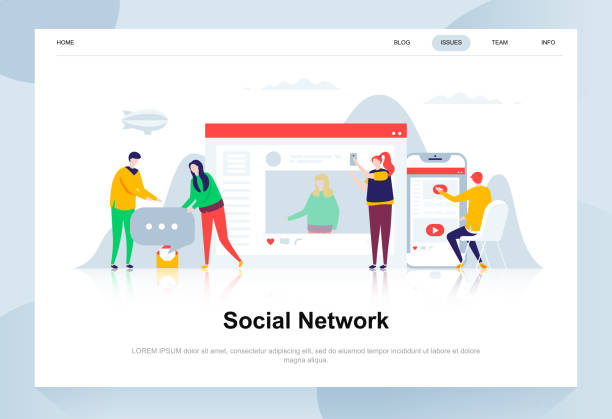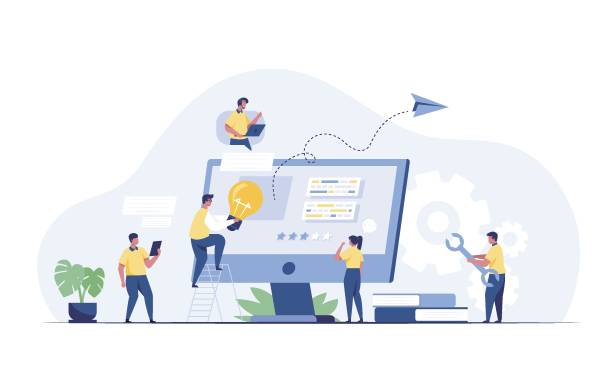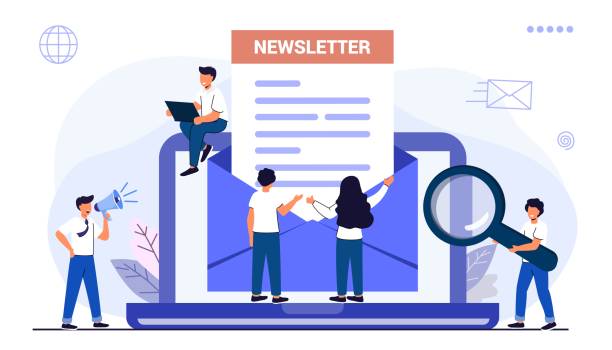Introduction to Secure Website Design: Why is Web Security Critical?

In today’s world, where #information_technology and #internet are considered the main arteries of life, an online presence is inevitable for every business or organization.
However, with increasing reliance on virtual space, cyber threats have also significantly increased.
This is where the concept of cybersecurity and especially secure website design, transforms from a choice into an undeniable necessity.
An insecure website can not only put sensitive user information at risk but also severely damage a brand’s reputation.
Loss of customer data, penetration into internal systems, and widespread attacks such as DDoS attacks, are just some of the dangers threatening vulnerable websites.
The main goal of secure website design is to protect data, maintain user privacy, and ensure continuous access to online services.
This includes not only technical measures but also continuous education and awareness to cover all aspects of digital security.
The importance of this issue is such that many international laws, such as GDPR, require organizations to adhere to the highest security standards.
Therefore, investing in secure website design is not just an expense, but a vital investment for the future and sustainability of any business in the online space.
Is your company’s website performing as it should, befitting your brand? In today’s competitive world, your website is your most important online tool. Rasaweb, specializing in professional corporate website design, helps you to:
✅ Build customer credibility and trust
✅ Convert website visitors into customers
⚡ Get a free consultation!
Identifying Common Web Threats and Prevention Strategies

To achieve secure website design, it is essential to first become familiar with the most common threats and vulnerabilities that target websites.
Attacks such as SQL Injection and Cross-Site Scripting (XSS) are among the most common methods hackers use for unauthorized data access or malicious code injection.
SQL Injection allows attackers to access the database by injecting SQL code into site inputs, while XSS targets users’ browsers by injecting malicious scripts into web pages.
Additionally, Brute Force attacks to guess passwords, phishing attacks to steal identity information, and software vulnerabilities due to outdated systems, are all serious challenges.
To counter these threats, there are numerous preventive measures.
These solutions include thorough user input validation, using secure protocols like HTTPS, implementing strong Multi-Factor Authentication (MFA) mechanisms, and regularly updating all software and libraries used.
A comprehensive approach to secure website design requires a deep understanding of these threats and the continuous application of best security practices to ensure the website is resilient against potential attacks.
Basic Security Protocols and Their Role in Web Security

Basic security protocols form the backbone of any secure website design.
One of the most important of these protocols is HTTPS, which uses SSL/TLS to encrypt communication between the user’s browser and the web server.
This encryption ensures that exchanged data, such as login information or credit card details, remains secure during transit and cannot be intercepted by third parties.
Installing an SSL/TLS certificate is an essential step for any website that aims to ensure user security and is also important for better search engine rankings, such as Google.
In addition to HTTPS, the use of Web Application Firewalls (WAF) is another key measure.
WAFs create a protective layer between the website and the internet, inspecting incoming and outgoing traffic to identify and block malicious attacks such as SQL Injection and XSS.
These tools play a vital role in preventing potential intrusions.
In the following, a table of the most important security protocols and their applications is provided:
| Protocol/Technique Name | Description | Security Objective |
|---|---|---|
| HTTPS/SSL/TLS | Encrypts data transmitted between user and server | Protection of privacy and data integrity |
| WAF (Web Application Firewall) | Filtering and monitoring HTTP/S traffic | Protection against application layer attacks (SQLi, XSS) |
| MFA (Multi-Factor Authentication) | Requires more than one method for user identity verification | Prevention of unauthorized access to user accounts |
| CSP (Content Security Policy) | Defines authorized sources for a web page’s content | Reduces XSS and code injection risks |
Implementing these protocols and techniques is an integral part of the secure website design process and assures website administrators that they have provided a resilient platform against common threats.
A comprehensive approach to web security requires combining these protocols with other security measures to create a multi-layered defense.
Database Security: The Backbone of Dynamic Websites

The database is the heart of every dynamic website, where all sensitive user information, transactions, and site content are stored.
Therefore, database security plays a vital role in secure website design.
Database intrusion can lead to personal information theft, data destruction, or even complete control over the website.
One of the most important measures to enhance database security is using Parameterized Queries or Prepared Statements to prevent SQL Injection attacks.
This method ensures that user inputs are not interpreted as executable code.
Furthermore, encrypting sensitive data in the database, especially Personally Identifiable Information (PII) such as contact numbers or addresses, is essential.
Even in the event of an intrusion, encrypted data will be useless to attackers.
Applying the Principle of Least Privilege, meaning that users and applications only have access to the information and operations necessary for their tasks, is another important principle.
OWASP Top 10 consistently ranks database-related attacks at the top of its vulnerability list, highlighting the importance of this issue.
Secure configuration of the database server, removal of default user accounts, changing to strong passwords, and regular updates of database software are other preventive measures.
Regular and secure backup of the database is also crucial for quick recovery in case of attacks or system failures.
This set of measures provides a solid foundation for a highly secure website and prevents serious vulnerabilities.
A specialized and meticulous approach to database security is an integral part of secure and sustainable website design.
Does your current corporate website present a fitting image for your brand and attract new customers?
If not, transform this challenge into an opportunity with Rasaweb’s professional corporate website design services.
✅ Significantly improves your brand’s credibility and image.
✅ Paves the way for attracting leads and new customers.
⚡ Contact Rasaweb now for a free and specialized consultation!
Authentication and Session Management: Beyond Simple Passwords

Authentication and session management are two key pillars in any secure website design that prevent unauthorized user access to the system.
Simply having a strong password is no longer enough.
Today, implementing more advanced mechanisms such as Two-Factor Authentication (2FA) or Multi-Factor Authentication (MFA) is essential.
These methods add another layer of security, such as a code sent to a mobile phone or a fingerprint, preventing intrusion even if the password is compromised.
Proper Session Management is also crucial for maintaining user security after logging in.
This includes using secure session tokens, encrypting session cookies, and setting expiration times for sessions.
Unlimited sessions or those with predictable tokens pave the way for attacks such as Session Hijacking.
Using HTTPS in all stages of authentication and session management is also vital to prevent information disclosure during transit.
Developers must be careful not to place session tokens in the URL and always send them via HTTP headers or secure cookies.
From a secure website design perspective, any negligence in this area can lead to disaster.
Establishing strong password policies that encourage users to choose complex and unique passwords, as well as implementing an Account Lockout mechanism after several unsuccessful login attempts, are other important solutions.
These measures ensure that user identities are effectively verified and unauthorized access to accounts is minimized, which are fundamental principles of website security.
Server Security and Choosing the Right Hosting

Website security is not limited to code and databases; server security and hosting infrastructure are equally important in secure website design.
Choosing a reputable hosting provider that adheres to high security standards is the first critical step.
These standards include hardware and software firewalls, Intrusion Detection and Prevention Systems (IDS/IPS), regular backups, and server security patch management.
Good hosting should be able to withstand DDoS attacks to ensure your website remains accessible even under high volumes of malicious traffic.
Secure server configuration includes disabling unnecessary services, changing default ports, and using up-to-date and stable operating systems.
Implementing strict Access Control Lists (ACLs) for files and directories, and continuous monitoring of server logs to identify suspicious activities are also critical measures.
Furthermore, using Content Delivery Networks (CDNs) can provide an additional layer of security in addition to increasing loading speed, as many CDNs have WAF capabilities and DDoS protection.
These recommendations are essential for anyone looking for secure and stable website design, and without attention to server infrastructure, no website will be completely secure.
Careful selection and proper server configuration are an integral part of a comprehensive website security strategy.
Continuous Updates and Security Audits: The Secret to Lasting Security

One of the biggest challenges in the world of cybersecurity is the dynamic and continuous evolution of threats.
For this reason, secure website design is not a static process but requires continuous updates and regular security audits.
No website will remain secure forever after launch, as new vulnerabilities are constantly discovered, and attack methods are always changing.
Updating the server operating system, CMS software (such as WordPress, Joomla), plugins, themes, and all libraries used, should be prioritized.
These updates often include critical security patches that address known weaknesses.
Neglecting these updates makes the website vulnerable to attacks that exploit common vulnerabilities (CVEs).
Security audits and Penetration Testing are also vital parts of this process.
These tests involve simulating cyberattacks to identify weaknesses in the system before hackers discover them.
Vulnerability scanning tools and manual reviews by security experts can help identify misconfigurations, vulnerable code, and other security risks.
This analytical and continuous approach ensures that secure website design is maintained over time and the website remains resilient against emerging threats.
A simple table for the update checklist:
| Update Item | Description | How often to perform? |
|---|---|---|
| Server Operating System | Linux/Windows Server and security patches | Monthly or immediately after critical patch release |
| Content Management System (CMS) | WordPress, Joomla, Drupal, and their core | At least quarterly or with each new version release |
| Plugins and Themes | All installed plugins and themes | Weekly or immediately after update release |
| Programming Libraries | PHP, Python, Node.js, and frameworks | Quarterly or with bug-fix releases |
| SSL/TLS Certificate | Timely renewal of security certificates | Before expiration (usually every 3 months to 1 year) |
This table serves as a guide for maintaining security and ensuring that your secure website design is an ongoing and dynamic concern.
Incident Response and Data Recovery: What to Do When Security is Breached?

Even with the best secure website design approaches, the probability of a security breach never reaches zero.
Therefore, having an Incident Response Plan and a Disaster Recovery Plan is an integral part of any comprehensive security strategy.
These plans should include specific steps for identification, containment, eradication, recovery, and lessons learned from security incidents.
Speed of action in responding to a security intrusion is crucial; the faster you can identify and contain an attack, the less damage will occur.
The incident response team must have clear responsibilities, including cutting off attacker access, identifying the source of the intrusion, and restoring the system to normal from secure backups.
Regular and tested backups of all website data and configurations are the foundation for successful recovery.
These backups should be stored in a secure location separate from the main server.
Another important aspect is transparent communication with affected users, especially if their personal information has been compromised.
This is not only a legal requirement in many countries but also helps to maintain user trust.
Root Cause Analysis after every security breach helps in continuous improvement of secure website design and prevents similar incidents from occurring in the future.
This analytical process makes your website more resilient against future threats and ensures that lessons are learned from every bitter experience to improve security.
Are you lagging behind in competition with large online stores?
Rasaweb, with professional e-commerce website design, brings your business online and increases your market share!
✅ Increases brand credibility and customer trust
✅ Easy shopping experience leads to more sales
⚡ Act now for a free website design consultation!
Legal and Ethical Aspects of Data Security

Alongside technical dimensions, secure website design also has important legal and ethical aspects.
Protecting user data is not only a technical necessity but also a legal and ethical responsibility for website owners.
Data protection laws like GDPR in Europe and CCPA in California, require organizations to adhere to strict standards in collecting, storing, processing, and sharing personal information.
Non-compliance with these laws can lead to heavy fines, loss of reputation, and legal disputes.
Transparency regarding how data is collected and used, providing users with the right to access and delete information, and obtaining their explicit consent for data processing, are fundamental ethical and legal principles.
Implementing a comprehensive and understandable privacy policy that is easily accessible on the website is essential for building user trust.
This part of secure website design goes beyond coding and requires an understanding of social and legal responsibilities.
You should ask yourself these questions: Do we really need all the data we collect? How can we minimize data-related risks? Are our users aware of how their information is used? The answers to these questions define the ethical and legal framework for your approach to website security and ultimately lead to a secure and reliable website design.
Cultivating Awareness and Educating Users in Online Security

Even the strongest firewalls and most complex security protocols are vulnerable to human error.
For this reason, cultivating awareness and educating users, both internal organization users and website end-users, plays a vital role in secure website design.
Many intrusions occur through social engineering or phishing, which target users.
Educating users about phishing risks, the importance of strong and unique passwords, and the dangers of clicking on suspicious links can significantly increase the overall security level.
Organizations should conduct regular training programs for their employees on cybersecurity best practices and continuously update these trainings.
For website end-users, providing simple and understandable guides on how to protect their user accounts, such as using two-factor authentication, can be very effective.
Creating a secure online environment is a shared responsibility that involves both website developers and administrators, and users.
By increasing user awareness and knowledge, they can act as the first line of defense against cyberattacks.
This educational aspect is often overlooked, but it is absolutely essential to complete the puzzle of secure website design and create a resilient digital ecosystem.
The question is: Are your users sufficiently trained to identify threats and protect themselves?
Frequently Asked Questions
| Row | Question | Answer |
|---|---|---|
| 1 | What is secure website design? | The process of designing and developing websites that are resistant to cyberattacks and protect user data and privacy. |
| 2 | Why is website security important? | To prevent data breaches, financial losses, damage to company reputation, and maintain user trust. |
| 3 | What are some common website security threats? | SQL Injection, XSS (Cross-Site Scripting), CSRF (Cross-Site Request Forgery), weak authentication, and outdated software. |
| 4 | What is SSL/TLS and what is its role? | Protocols for encrypting data between the user’s browser and the website server, ensuring secure and private communication. |
| 5 | How can SQL Injection attacks be prevented? | By using Prepared Statements/Parameterized Queries, input validation, and ORMs (Object-Relational Mappers). |
| 6 | What is the role of a Web Application Firewall (WAF) in security? | A WAF monitors and filters HTTP traffic between a web application and the internet to prevent malicious attacks. |
| 7 | Why are regular updates of software and libraries essential? | Updates include patches for known security vulnerabilities that attackers can exploit. |
| 8 | How can XSS attacks be prevented? | By sanitizing and escaping all user inputs before displaying them on the web page and using a Content Security Policy (CSP). |
| 9 | What does the Principle of Least Privilege mean? | It means that users and systems are granted only the minimum necessary permissions to perform their tasks, to prevent unnecessary access to resources. |
| 10 | What is the importance of proper user session management? | To prevent user session hijacking and unauthorized access to user accounts through secure and expiring session tokens. |
And other services of Rasaweb Advertising Agency in the field of advertising
Smart Social Media: A combination of creativity and technology for digital branding through precise audience targeting.
Smart Customer Journey Map: Designed for businesses looking to increase click-through rates through Google Ads management.
Smart Direct Marketing: A combination of creativity and technology for user engagement through SEO-driven content strategy.
Smart Data Analysis: An innovative service for increasing user engagement through Google Ads management.
Smart Digital Advertising: An innovative service for increasing customer behavior analysis through optimizing key pages.
And over hundreds of other services in the field of internet advertising, advertising consulting, and organizational solutions
Internet Advertising | Advertising Strategy | Advertorials
Resources
The Importance of Site Security in SEO
Why is Website Security Important?
Website Security Checklist for Online Businesses
Comprehensive Website Security Checklist
Are you ready to boost your business in the digital space? Rasaweb Afarin Digital Marketing Agency offers a wide range of professional services, including e-commerce website design and comprehensive SEO strategies, to help you achieve your online marketing goals and establish a strong and successful online presence.
📍 Tehran, Mirdamad Street, next to Bank Markazi, Kazeroun South Alley, Ramin Alley, No. 6

